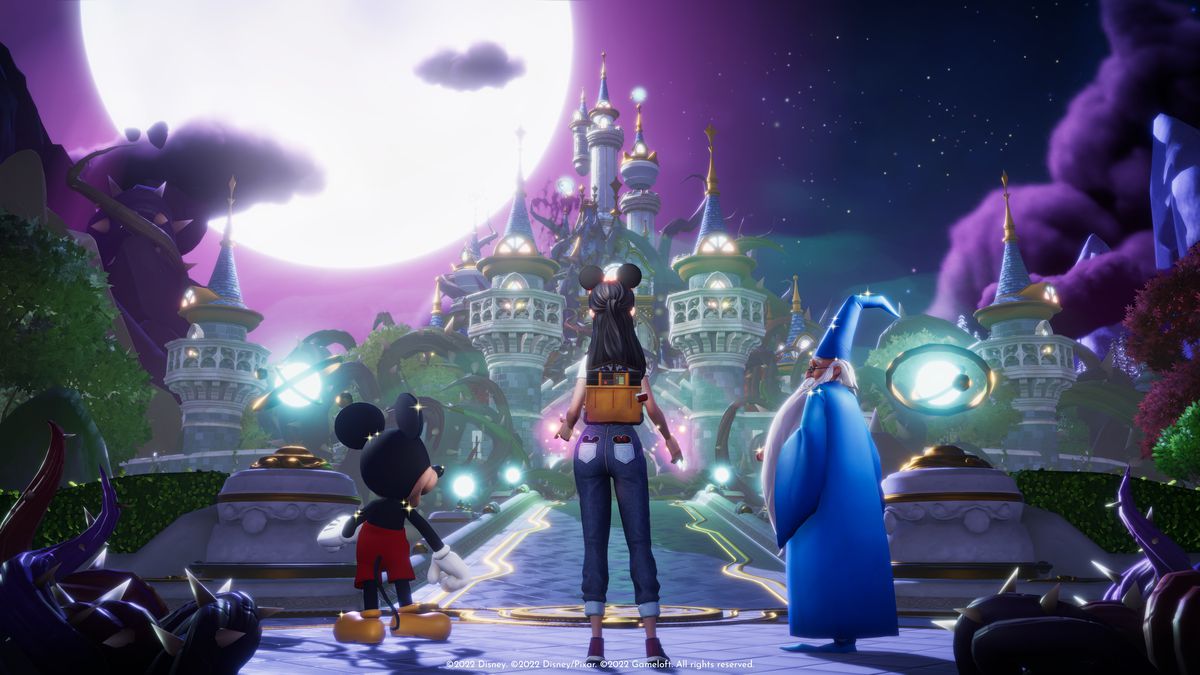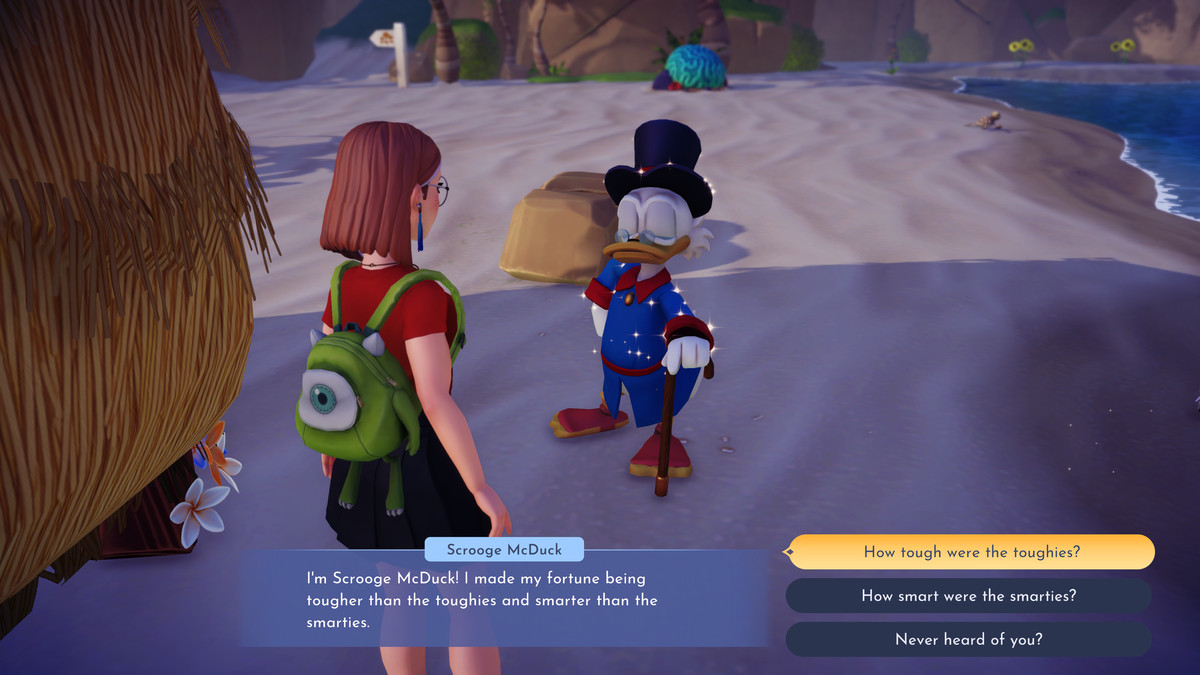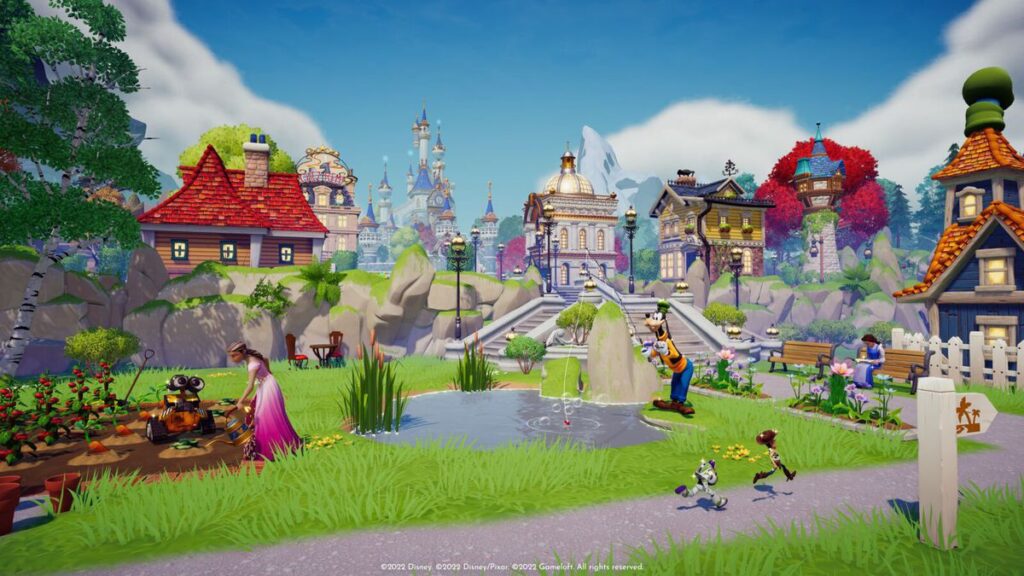What happens when you throw The Lion King’s Scar — a lion who literally killed his brother for power — into the idyllic world of Disney Dreamlight Valley? Chaos, that’s what. Part of the challenge for developer Gameloft is navigating character relationships across a whole bunch of different Disney and Pixar worlds. But so far, that’s included things like teaching Frozen’s Anna about tacos and pizza, or introducing WALL-E to The Little Mermaid’s Ariel, so they can trade their found items. Scar is a little different.
“How does that character interact with, say, Remy?” Disney Dreamlight Valley senior world designer Josh Labelle asked. “Scar is the chaos element in the village.”
Disney Dreamlight Valley launched in early access this year, but not without troubles like game-locking bugs and scarce resources. Despite those hurdles, however, the game amassed more than 1 million players in just over a week. A bunch of content is still to come, including the aforementioned Scar, scheduled to be released this fall. After that, Disney Dreamlight Valley will get a Toy Story update with its own new characters, slated for later this fall.
In an interview with Polygon, Labelle and Disney Dreamlight Valley creative director Nicholas Mainville spoke about blending characters and worlds together inside Dreamlight Valley, a totally new world built for these different interactions.
[Ed. note: This interview has been lightly edited for length and clarity.]
Image: Gameloft
Polygon: How would you describe Disney Dreamlight Valley to someone?
Josh Labelle: For us on the team and hopefully for the players, Disney Dreamlight Valley is an invitation to reconnect with your inner child, and reconnect with all the Disney properties that you love — to get to live among them.
Who were you thinking of as the audience? When I first heard of the game, I thought it was for kids, but I felt different after I started playing it, as someone who sort of left Disney characters behind.
Nicholas Mainville: We were aiming for a target demographic of young adults, the goal being to be able to be a bit more serious about some subjects that we’re tackling. But it’s still meant to appeal to a younger audience as well. While we’re trying to have young adults like us who grew up with the Disney movies, and maybe lost touch with them over the years, Disney Dreamlight Valley aims to be a way to reconnect with that inner child, but also as a means to help younger people discover the characters we grew up loving.
Labelle: One thing that was really exciting when the game was announced was that I had friends who found out I was working on it, friends who are huge life sim fans and huge Disney fans, and they came to be so excited to be able to play it. And then I had my other friends who were excited to play with their kids. I actually have some friends who are playing with their kids — one who is playing it with his two young daughters. That’s what’s really exciting about it, that you can connect to it on different levels.
One of my friends grew up loving The Sword in the Stone and the classic characters [like Merlin], so for him it’s exciting to interact with them. His kids have no reference point for those characters, and this is their introduction to them. But they’re really excited to meet WALL-E and hang out with him, to meet Moana and hang out with her.
You can play it with your friends, but just like when you watch Disney or Pixar movies, there’s things that might go over the heads of kids, that the adults watching will appreciate. We hope the game works in the same way.

Image: Gameloft
What do you think makes the game work? How do you make it feel natural to merge so many different worlds and IPs into this life and farming simulator?
Mainville: The first thing that really helped was that we created our own IP that is Dreamlight Valley itself. That’s our own world, our own story that benefits from these rich characters that have a place to interact with each other. That really helps.
But the pure love of the team for games and Disney, everything Disney related, really shines in our game. People can appreciate and see the love we have for those IPs, even in the smallest details. There are deep cuts of little things in the movies that only fans would know about.
Labelle: On the narrative side, we did a lot of work with Disney in the past year, especially to make it so the characters are coming at the world of Dreamlight Valley from their own perspectives. We always want to respect the rules of the individual worlds that these characters are coming from. Merlin has his frame of reference for this magical world, but then we have other characters who might not have magic in their world, so for them, being in Dreamlight Valley is much more of a discovery. Understanding these roles and playing by them has been a challenge, but I think it’s why it works.
Mainville: We know the stories of these characters, but there are new things to learn about them. Dreamlight Valley expands their universe. So if you love a character, let’s say WALL-E, you can go on a different adventure with him that you haven’t experienced anywhere else.
I’d love to hear more about these rules and how you decide what a character would do — or not do.
Labelle: We always keep in within the frame of reference of the individual movies a character comes from. If you’re talking with WALL-E, WALL-E isn’t going to be able to explain to you how some curse works in the Valley, or how some magic enchantment works. If we want to have some component like that in a quest with WALL-E, we have to find a way to do it that’s going to respect that. Often it involves talking with Merlin, who is the only guy in town who really understands what’s going on with magic.
There’s a lot of things we try to respect with regards to characters from Moana or Frozen. They come in from worlds where their technology is at a certain point, and we don’t want to violate that. If we’re having you take a photograph of a certain character from Frozen or Moana for example, we want to have them react in a way that’s true to the world they come from. They’re not going to react to your camera in a way where they completely understand what’s going on.
Are there any Disney or Pixar characters that are off-limits?
Mainville: So far, we have the ones that are in the game for sure. We definitely have more coming. We have a huge roadmap and we’re working closely with Disney to choose which characters we’re going to bring in. We’re really focusing on Pixar and Disney classics. Everything’s kind of on the table.
How do you make sure you’re writing these characters in their voices, while making them interact with characters from other worlds? Like WALL-E and Ariel, for instance.
Labelle: We get a lot of help from Disney on that. We really look at every line of dialogue to ensure that it’s true to those characters and their experience. Collaboration has been very good. To make sure these characters feel like themselves, I will sit down and watch the movies again. I will sometimes take a scene from the movie and type it out in a screenwriting program so I can get the cadence of the voices, the kinds of words they might use. I’ll make a vocabulary sheet that says, Ariel uses these words in the movies. I’ve never heard her use these words, so maybe stay away from them. That’s kind of the way we do it. It’s always going back to the source text of the film and listening, really listening, to the dialogue.
When we’re having them interact, we throw in that chaos element of what the characters wouldn’t understand about each other. How do we explore that?

Image: Gameloft via Polygon
One thing I enjoyed is that you can be a little bit rude to the characters. It’s refreshing. Where do you know when to draw the line on what’s OK or what’s too much?
Labelle: It’s funny. I love to see mean choices in games but I rarely select them. That’s basically true across the board. I’ve seen data on other games where it’s like, 10% of people will pick a mean choice. For instance, I remember the Mass Effect team talking about that exact same breakdown for Renegade choices. People very rarely select the mean choices.
My principle with the mean choices is always that the actual text has to be extremely funny. For a lot of players, that’s going to be the only part they’re going to see. They’re not necessarily going to see the reaction if they choose it, because people want to be nice, which is kind of a good thing.
We have a little more room to play with the villains. You can push a little bit more on the villains and have them react hilariously. With the hero characters, we try to make it so that it’s a bit sassy. It’s not disrespectful to who the character is. We try to make it more embodying something about the player. So if the nice choice is modest and helpful, the mean choice will be a little more braggadocious.
And when people do select those options, we take the time to get you back on the path of the conversation; you smooth over the rude thing you’ve said.
Mainville: On a broader aspect of the game, we really wanted Disney Dreamlight Valley to be a game in which players can be themselves and express themselves. That’s true of the character customization and all the options that we have provided, but it’s also true with the dialogue choices. A big thing about Disney movies is that there are heroes and villains. It embodies that concept in dialogue choices where you can really express yourself as a mini villain in some choices, but mostly as the hero of Dreamlight Valley, because in the end, you’re there to save it.
Labelle: It can work as a nice frustration valve for players. If a player is feeling like, Scrooge is asking me to do what now? it can be nice to have the ability to say, You’re asking me to to do what now? too.
Let’s talk about what’s coming next — the game is in early access, so there must be a bit. What can players expect?
Mainville: I can definitely tell you that we have a huge roadmap ahead of us. There’s an update coming soon, with the continuation of the main story and [The Lion King’s] Scar. After that, we’ll have an update with Toy Story. But there’s a lot more to announce for next year as well.
Labelle: With the next two updates, there’s a lot of exciting narrative stuff. A couple of big secrets are being revealed. And, you know, with Scar, that’s a very exciting character. Scar is this chaos element in the village. We talked about the characters and their different frames of references, and with Scar, you’re throwing a lion into Dreamlight Valley — and particularly a lion like Scar. How does that character interact with, say, Remy? That’s going to be a lot of fun.
Is there a timeframe for when Disney Dreamlight Valley will leave early access?
Mainville: We don’t have anything to announce yet, but we will have more information on that in the near future.

